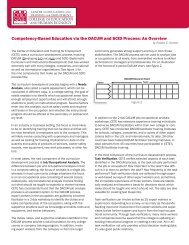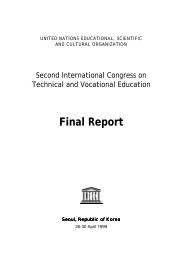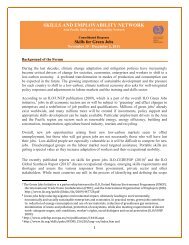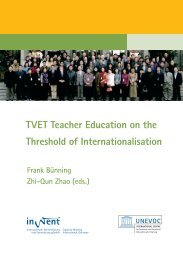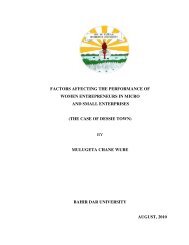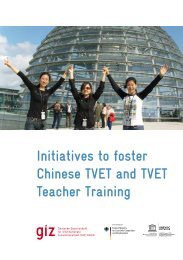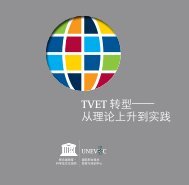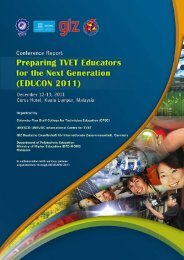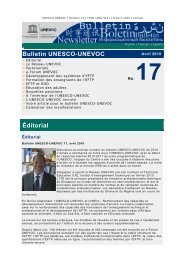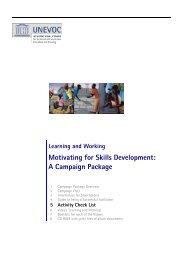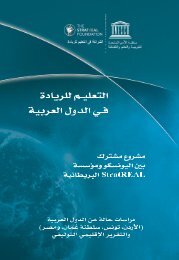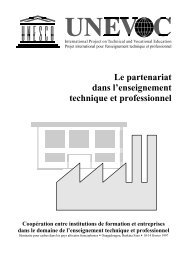Corporate HRD and Skills Development for ... - Unesco-Unevoc
Corporate HRD and Skills Development for ... - Unesco-Unevoc
Corporate HRD and Skills Development for ... - Unesco-Unevoc
You also want an ePaper? Increase the reach of your titles
YUMPU automatically turns print PDFs into web optimized ePapers that Google loves.
industry, professional associations, <strong>and</strong>/or labour organizations is necessary in order to<br />
enhance the recognition of the certificates.<br />
4. From measuring knowledge <strong>and</strong> skills acquired at VTET institutions to a combination of<br />
<strong>for</strong>mal, in<strong>for</strong>mal, <strong>and</strong> non-<strong>for</strong>mal lifelong learning. Considering that learning processes<br />
can occur in various places <strong>and</strong> in various ways, assessment procedures should incorporate<br />
these different types of learning. The distinction among the three is becoming blurred <strong>and</strong><br />
should not be over emphasized. The more important consideration is how well the<br />
c<strong>and</strong>idates can per<strong>for</strong>m their jobs.<br />
5. From focusing on “hard” skills, to a combination of “hard” <strong>and</strong> “soft” skills assessment.<br />
Various studies have showed that in order to per<strong>for</strong>m the job successfully, an employee<br />
should not only master specific technical skills, but he or she should possess other important<br />
attributes, e.g. team work ability, a work ethic, <strong>and</strong> communication skills. These “soft skills”<br />
are equally important, if not more so, than the “hard skills” <strong>and</strong> are there<strong>for</strong>e worth<br />
considering as part of the assessment process.<br />
6. From local orientation to more global orientation in terms of scope <strong>and</strong> recognition. <strong>Skills</strong><br />
st<strong>and</strong>ards are based on the dem<strong>and</strong>s of the market where the c<strong>and</strong>idates are planning to<br />
work. Realizing that labour mobility is very high within <strong>and</strong> across nations, addressing the<br />
needs of local or even national dem<strong>and</strong>s has been deemed to be insufficient. The scope <strong>and</strong><br />
contents should be broad enough to provide c<strong>and</strong>idates with increased flexibility in order to<br />
work not only at the local level, but also at national or even international level. The c<strong>and</strong>idates<br />
should be flexible whether they want to work <strong>for</strong> others or <strong>for</strong> themselves.<br />
Focusing the three themes under skills st<strong>and</strong>ards: content <strong>and</strong> scope, assessment, <strong>and</strong><br />
certification, this section will highlight some of the salient issues <strong>and</strong> challenges faced by<br />
Southeast Asian countries.<br />
7. St<strong>and</strong>ards<br />
The issue of what should be included in the skills st<strong>and</strong>ards, the basic (adaptive) skills, the<br />
specific (productive) skills, <strong>and</strong> the attitude/normative – or soft skills – should be addressed.<br />
In terms of scope, whether the skills st<strong>and</strong>ards will be focused on local, national, regional,<br />
or international level dem<strong>and</strong>s is another area that should be elaborated upon <strong>and</strong> agreed to.<br />
8. Assessment<br />
The issue of who should assess the trainees, techniques, <strong>and</strong> types of as-sessment should be<br />
clarified <strong>and</strong> agreed to by the relevant stakeholders. Currently, training providers are the sole<br />
assessors. Considering that train-ing providers suffer a conflict of interests, independent or<br />
external assessors are necessary, such as business <strong>and</strong> professional associations.<br />
The assessment that relies too much on exams <strong>and</strong> skills demonstration should be<br />
accompanied with documents that can be supplied by the participants in the <strong>for</strong>m of a<br />
portfolio.<br />
18



